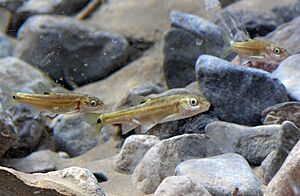Moapa dace facts for kids
The Moapa dace (Moapa coriacea) is a very rare fish that lives only in southern Nevada, United States. You can find it in the upper parts of the Muddy River and in the warm springs that feed the river. This special fish is the only species in its group, called Moapa.
Quick facts for kids Moapa dace |
|
|---|---|
 |
|
| Conservation status | |
| Scientific classification | |
| Synonyms | |
|
Gila coriacea |
Contents
What Does the Moapa Dace Look Like?
The Moapa dace is a small fish. It usually grows to about 9 centimeters (about 3.5 inches) long. Its scales are tiny and are hidden in its skin. This makes the fish feel a bit leathery when you touch it. That's why its scientific name, coriacea, means "leathery" in Latin! The fish has a body shape that is common for its type, with a head that is somewhat cone-shaped.
Where Does the Moapa Dace Live?
Moapa dace need warm water to survive. They can live in water temperatures from about 19 to 34 degrees Celsius (67 to 93 degrees Fahrenheit). They like to live in places where there is a lot of algae and shade. They prefer areas with gravel, sand, and mud at the bottom.
The Moapa dace eats many different things, which means it has an omnivorous diet. This includes both plants and small animals found in the water. The entire area where this fish lives is very small. It is less than 10 square kilometers (about 4 square miles) in Clark County, Nevada.
Moapa Dace Life Cycle and Reproduction
The Moapa dace usually reproduces the most in spring. They reproduce less in the fall. They lay their eggs in the small streams that feed the main river. Spawning, which is when fish lay eggs, happens within 150 meters (about 490 feet) of the warm springs. The water temperature for spawning is usually around 30 to 32 degrees Celsius (86 to 90 degrees Fahrenheit).
These fish often reproduce in spots where there is cover over the water, like plants or rocks. They also like water that flows at a gentle speed, about 0.11 to 0.17 meters per second.
Why Is the Moapa Dace Endangered?
The Moapa dace is a critically endangered species. This means it is at a very high risk of disappearing forever. It was first listed as endangered in 1967 by the United States government. In 1996, it was classified as critically endangered.
Many things threaten this fish. One big problem is the loss of its home, called habitat. This happens because of new buildings and resorts being built. Another threat is when new types of fish are brought into the area. These new fish can compete with the Moapa dace for food or even eat them. Also, the natural springs that feed their habitat can be used up or changed, which reduces the water they need.
In 1994, a fire at the Moapa National Wildlife Refuge caused the number of Moapa dace to drop a lot.
Protecting the Moapa Dace
The Moapa National Wildlife Refuge was created just to protect the Moapa dace. It was the first wildlife refuge made to save an endangered fish! Scientists are working hard to help these fish. They have even built special artificial streams that are just like the perfect home for the Moapa dace. They hope these new streams will help the fish population grow.
Researchers have also studied how stress affects the fish. They found that stressed fish had a much higher chance of dying. This shows how important it is to keep their environment safe and calm.



